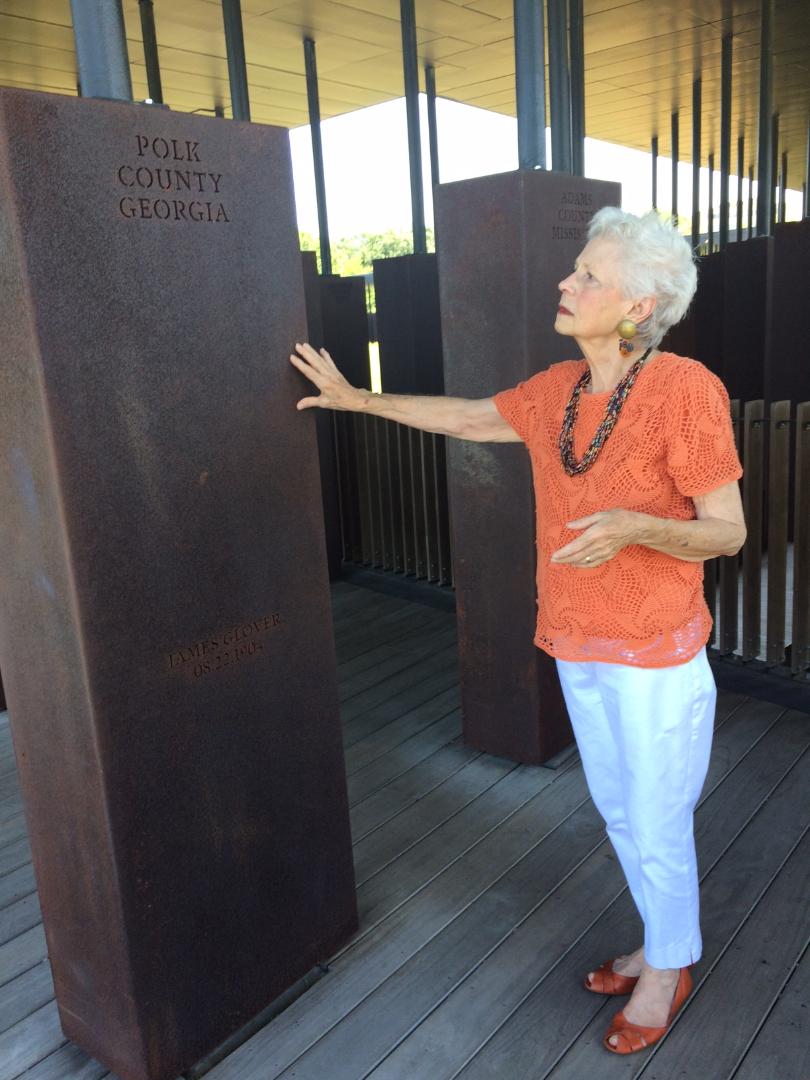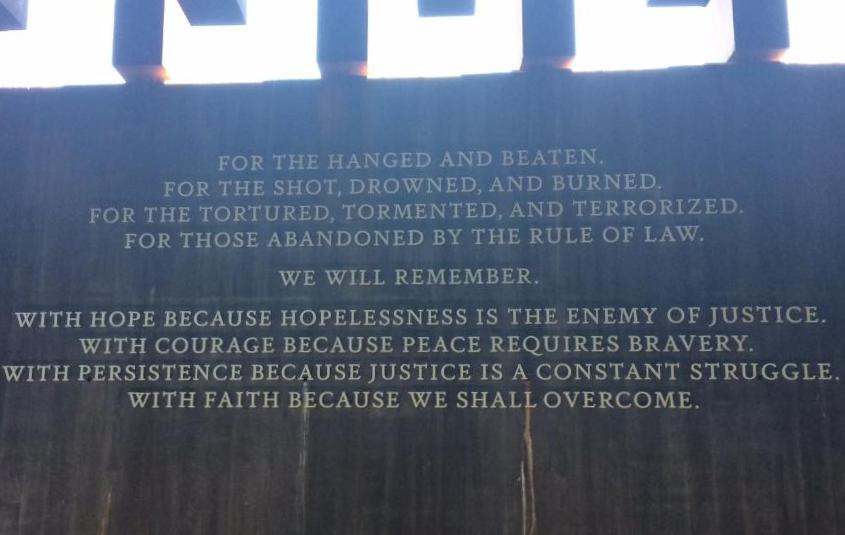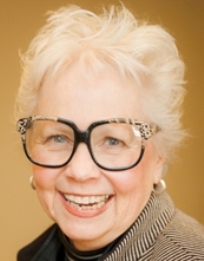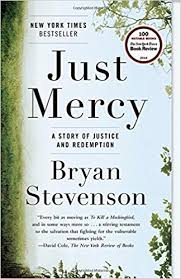A Visit to the Lynching Legacy Memorial in Montgomery, Alabama (August 2019)
In his book Tears We Cannot Stop: A Sermon to White America,
Michael Eric Dyson includes a list of things majority culture people
can do to understand the obdurate presence of racism in our national
life. “Beloved, you must also educate yourself about black life and
culture. Racial literacy is as necessary as it is undervalued.”
Last
summer, from May to August, while in the grips of a dysphasia that
caused me to lose 43 pounds (unintentionally), I did just that—educate
myself. The New Jim Crow is on my dedicated bookshelf space, as is White Fragility, The Cross and the Lynching Tree, White Awake, The Color of Water, Whistling Vivaldi, Blindspot and Why Are All the Black Kids Sitting Together in the Cafeteria? None of these, as far as I can tell, are included in Dyson’s list of must-reads, his starting with James Baldwin’s The Fire Next Time.
Though
this pile of mine is daunting reading, I realized when comparing my
list of titles to Pastor Dysons’s suggestions that I have hardly
started in this self-appointed journey of becoming racially literate. I
too want to repeat the phrase so familiar these days, Well, I’m not racist. However, my recent plunge into the topic has convinced me that the concept of a recovering racist describes myself more accurately.
All
this despite the fact that in the later part of the 1960s, David and I
were part of a small cadre of evangelicals who committed themselves to
attempting to do something about the racial divide in American
churches. We planted a church on Chicago’s west side with an
intentional commitment to build an interracial staff and an interracial
congregation. This racism despite the fact that for six years in the
1990s, we were the only whites who attended an all-black congregation.
You
see, white privilege is the milieu into which I was birthed, a status
of life granted extravagantly, not earned; absolutely taken for
granted; and rarely, until this last decade, widely examined. It is a
condition of being I have only lately started to gaze at in the mirror
of my existence, guided by the articulate and sometimes not-so-gentle
explanations of the authors of the books mentioned above.
So
until those of us who are members of this societal strata begin to
really examine the privileges of whiteness and struggle to understand
how that privilege actually inhibits the full development of other
races through conscious or unconscious systemic prohibitions, which
inevitably displays itself in culture as a racist status-quo—we cannot make significant progress. So, I
have ordered Ibram X. Kendi’s Stamped From the Beginning, his history of racist ideas and winner of the National Book Award and also his new book How to Be an Antiracist.
I may be a recovering racist, but at least I am determined to be an educated one.
In all of this, last summer (at about the negative weight loss of 23 pounds), I plunged into Bryan Stevenson’s Just Mercy: A Story of Justice and Redemption
and discovered the voice of a true American leader. As a young
attorney, Stevenson founded the Equal Justice Initiative, established
as a legal practice dedicated to “defending the poor, the wrongly
condemned, and those trapped into the furthest reaches of our criminal
justice system. One of his first cases was that of Walter McMillan, a
young man sentenced to die for a notorious murder he didn’t commit.
This case opened for Stevenson a tangle of conspiracy, political
machination and legal brinkmanship.” (back-cover copy)
The
EJI was responsible for conceiving of and erecting the Lynching
Memorial in Montgomery, Alabama, which opened last year when I hit
negative weight loss of about 30 pounds. It is a “comprehensive
memorial dedicated to racial terror lynchings of African Americans and
the legacy of slavery and racial inequality in America.” The Clarion Journal, writing about the opening of the memorial, uses stark language to describe its impact:
Visitors
to the new National Memorial for Peace and Justice first glimpse them,
eerily, in the distance: Brown rectangular slabs, 800 in all, inscribed
with the names of more than 4,000 souls who lost their lives in
lynchings between 1877 and 1950.
Each pillar is 6 feet (2
meters) tall, the height of a person, and made of steel that weathers
to different shades of brown. Viewers enter at eye level with the
monuments, allowing a view of victims' names and the date and place of
their slaying.
As visitors descend downward on a slanted
wooden plank floor, the slabs seemingly rise above them, suspended in
the air in long corridors, evoking the image of rows of hanging brown
bodies.

I was determined to go, to drive the 13
hours and be one of the white Americans honoring the goal of
resurrecting a gruesome national history heretofore relegated mostly to
sidebars and short articles in schoolbooks and dusty stacks in library archives.
Instead, wiser heads prevailed (I also missed my grandson’s wedding),
and David and I fit that journey to Montgomery this August of 2019.
There
aren’t many “sacred” places left in the world. Even our cathedrals are
often full of shuffling tourists. Church doors are mostly locked during
the week. Sometimes we feel awe—at the Grand Canyon, for instance, or
at the seemingly endless sweep of a prairie or at acres of land waving
with growing wheat. We are rarely hit with the impact of a physical
monument, however, with the kind of power that makes you want to fall to
your knees, raise your hands and say, “Surely the Lord is in this pace.”
Better
yet, rare is the fall-flat-on-your face in the ancient posture of being
undone before something greater than you can comprehend.
The
Lynching Memorial has signs on the walls: “This is a sacred space,” and
asks visitors to act accordingly. Richard Jones in the Winston-Salem
Journal attempts to describe it all: “Inside the open-air structure,
visitors walk among the hanging steel coffin-sized monuments—one for
each county in which a lynching took place—silently or speaking in
hushed tones. … Between 1877–1950, 4,000 Americans were lynched, mostly
but not exclusively in the South, taken from their homes or jails where
they were awaiting trial as accorded by the Fifth Amendment to the
Constitutions and ‘swung from the limb of a tree,’ as a North Carolina
newspaper put it. That’s an average of one lynching each week for 3
years.”

Plaques on the wall (as the wooden walkway descends
deeper into the Memorial and the bronze coffins now hang above your
head) commemorate individual acts of horror, such as these:
David
Walker, his wife, and their four children were lynched in Hickman,
Kentucky in 1908 after Mr. Walker was accused of using inappropriate
language with a white woman.
A lynch mob of more than 1,000 men, women and children burned Zachariah Walker alive in Coatsville, Pennsylvania, in 1911.
Mary
Turner was lynched with her unborn child, at Folsom Bridge at the
Brooks County Line in Georgia in 1918 for complaining about the recent
lynching of her husband, Hayes Turner.
At least, the dirge I sing, I am a racist recovering, is no longer a solo soliloquy. There are others bowing their heads in a dirge of horror. To quote Richard Groves again:
A
young Muslim mother said in an interview after 9/11 that on seeing the
planes explode into the World Trade Center her unpremeditated prayer
was, “Dear God, don’t let them be Muslim.” She feared other Americans
would generalize their feelings about the ones who flew the planes to
all Muslims, to her and her family.
When
I heard that a gunman had shot his way into the newsroom of the Capital
Gazette and killed five people, I did not pray, ‘Dear God, don’t let
him be white,’ even though most mass shooters are white. I knew that no
one would think that his murderous impulses, whatever they were, were
somehow connected to the pigmentation of his skin. His atrocity had
nothing to do with me as a white man.
Yet when I stood
beneath the hanging steel monuments—“strange fruit” indeed—in the
lynching memorial, and when I stood wordlessly beside other visitors,
most of whom were African-Americans, before a display of more than 200
jars containing dirt from an equal number of lynching sites, each jar
bearing the name of a black man who was lynched there, I felt white.
And I was ashamed.

Ta-Nehisi Coates used his book Between the World and Me
to pen a letter to his son about growing up Black in a
white-power-structure world. The father recapitulates American history
and explains how “racist violence has been woven into American
culture.” Coates sees white supremacy as an indestructible force, one
that Black Americans will never evade or erase but will always struggle
against.
I am no prophet and I hope the author is wrong, but
with some sort of foreboding premonition, I suspect he is right.
Yet—yet, because I am part of the white culture, I dare to hope,
arrogant as this might seem to others, naïve due to my lack of personal
suffering due to the permanence and evil of systemic racism, due to the
fact that I am essentially and indubitably Christian and therefore, not
only on the one hand skeptical due to evil’s horrific hold on the heart
of humans, but still consistently hope-filled—I pray that he is wrong.
I
would like, personally, to advance from this state of being a recovered
racist to that of being a mostly recovered racist. At the least, I want
to become someone who is not ignorant about the racial horror embedded
in the genetic DNA of our country’s culture. I do not want to defend it
or explain it away. I do not want to burrow into a self-protective
cocoon because nothing (except my own conscience) demands that I
intentionally inform myself to the cries of my culture. Instead, I vow
to expose myself and my mentality to the humiliations and terrors and
violations that others have suffered essentially because their skin is
a different color from my own.

Robin DiAngelo writes in her book White Fragility: Why It’s So Hard for White People to Talk About Racism,
“The very real consequences of breaking white solidarity play a
fundamental role in maintaining white supremacy. We do indeed risk
censure and other penalties from our fellow whites. We might be accused
of being politically correct or might be perceived as angry, humorless,
combative, and not suited to go far in an organization. In my own life,
these penalties have worked as a form of social coercion. Seeking to
avoid conflict and wanting to be liked, I have chosen silence all too
often.”
My Scripture reading for this morning was from that seminal chapter in Isaiah, chapter 58, verses 9-11:
“If you do away with the yoke of oppression,
with the pointing finger and malicious talk,
and if you spend yourself in behalf of the hungry
and satisfy the needs of the oppressed,
then your light will rise in the darkness
your night will become like noonday.
The Lord will guide you always,
He will satisfy your needs in a sun-scorched land
And will strengthen your frame.”
If
we take this Scripture as a universal promise rather than an individual
one, how can we—a corporate, breathing entity of people who want to
change the present but must do so only with a recognition of the
past—not clutch tightly to hope? I, for instance, will give myself to
learning how to “satisfy the needs of the oppressed.” I will, at the
least, attempt to hear their voices and learn to listen to their
stories.
I may be a recovering racist, but at least I am becoming an educated one.
Karen Mains
NOTICESI Bid Your Prayers
In
some of the churches we have attended, the pastor or a deacon often
calls the people to prayer by saying, “I bid your prayers for
___________. Then, the congregants fill in the blanks.
So,
in these notices, I bid your prayers for my writing. (You can fill it
in with your own words.) Through the 18 years that I have been working
with Hungry Souls, I and teams of people working alongside me, have
accumulated well-tested spiritual-growth ideas that have been designed
in multiple of tools—all of which need to be published and made
available to other would be users.
So instead of
conceptualizing other ideas, I feel the need to finish all this work
while I still have time. Believe me, this is a labor of love. And even
though it is a loving project, it still entails all kinds of hours,
days and months in front of a computer screen.
So I bid your prayers for ___________________. You can fill in the blank.
I
also feel called to write out into general culture, into those secular
markets that don’t have a clue as to who Karen Mains is and who will
have to prove to them that she does have writerly capabilities.
Consequently, I spent a lot of last month pulling together a cover
package to sell my writing potential to New York literary agencies in
order that I might have someone to present my articles, book proposals,
etc. to secular publishing houses.
It has been a daunting
task, to say the least. One cover letter written, edited and designed.
One brief bibliography of the books I’ve written in religious markets (23 at last count).
One query letter; mine is titled “Beware Little White-Haired Ladies.”
One book proposal (Uncommon Goodness:
How Renegade Leaders Create Virtuous Circles That Defeat Vicious Cycles
of Poverty, Ignorance, Disease and Despair). One sample
chapter, and since this book is about the “renegade” leaders who do
good in the world, one profile of real people who challenge the ills of the world—the only piece in this puzzle that has
still to be created.
No wonder I am mentally exhausted! From
the past of dim memory, I recall some writer friend saying that pulling
all the above stuff together is about as much work as writing the book
itself. That vague statement has been some comfort.
Once
that short profile is written, I have several articles ready to adapt
and send out to secular periodicals! My goal is to submit 50 (fifty?!) articles by the end of this year.
I will never run out of ideas, but I will run out of stamina. I bid your prayers. Reminder!
The Soulish Food e-mails are
being
posted biweekly on the Hungry Souls Web
site. Newcomers can look that over and decide if they want to
register on the Web site to receive the biweekly newsletter. You might
want to recommend this to friends also. They can go to www.HungrySouls.org.
Hungry Souls Contact InformationADDRESS: 29W377 Hawthorne Lane
West Chicago, IL 60185
PHONE: 630-293-4500
EMAIL: karen@hungrysouls.org
|
|

Karen Mains
I vow to expose myself
and my mentality to the humiliations and terrors and violations that
others have suffered essentially because their skin is a different
color from my own.
BOOK CORNER
 Just Mercy: A Story of Justice and Redemption Just Mercy: A Story of Justice and Redemption
by Bryan Stevenson
After reading this book, I thought to myself, This man, certainly, is one of the rising leaders of our country. Thank God.
Bryan
Stevenson, the founder of the Equal Justice Initiative, tells that
story in this book. The back-cover copy touts the man’s credits: “From
one of the most brilliant and influential lawyers of our time comes an
unforgettable true story about the redeeming potential of mercy.”
Of
course, a reader expects such praise from book-cover copy; it’s written
by staff in whatever house has published the book. What one doesn’t expect are the outside accolades. These can’t be manufactured by editors. After that most coveted of prizes “#1 New York Times Bestseller,” the list reads as such:
“Named one of the best books of the year by The New York Times • The Washington Post • The Boston Globe • Time • The Seattle Times • Esquire.
Then—“winner of the Carnegie Medal for Excellence in Nonfiction; winner
of the NAACP Image Award for Nonfiction; winner of the Books for a
Better Life Award; finalist for the Los Angeles Times Book Prize; finalist for the Kirkus Prize, and an American Library Association Notable Book.”
These
kudos alone would make most wannabe readers at least pick up the book
and browse the pages. I guarantee, however, that pure goodness radiates
through the reading, and, indeed, mercy is restored as an admirable and
desired trait for much of what ails our often bitter and heartless
society.
In the powerful book Lynching in America,
which David and I picked up in the bookstore of the Lynching Memorial,
compiled and written by the EJI staff, James Stevenson is mentioned
once, and a photo of him with the EJI staff highlights the monumental
work they did for the memorial. He remains nameless.
The man, obviously, is not one of the “hot shots” among the rising leaders of our times.
Get the book. Read it.
|





